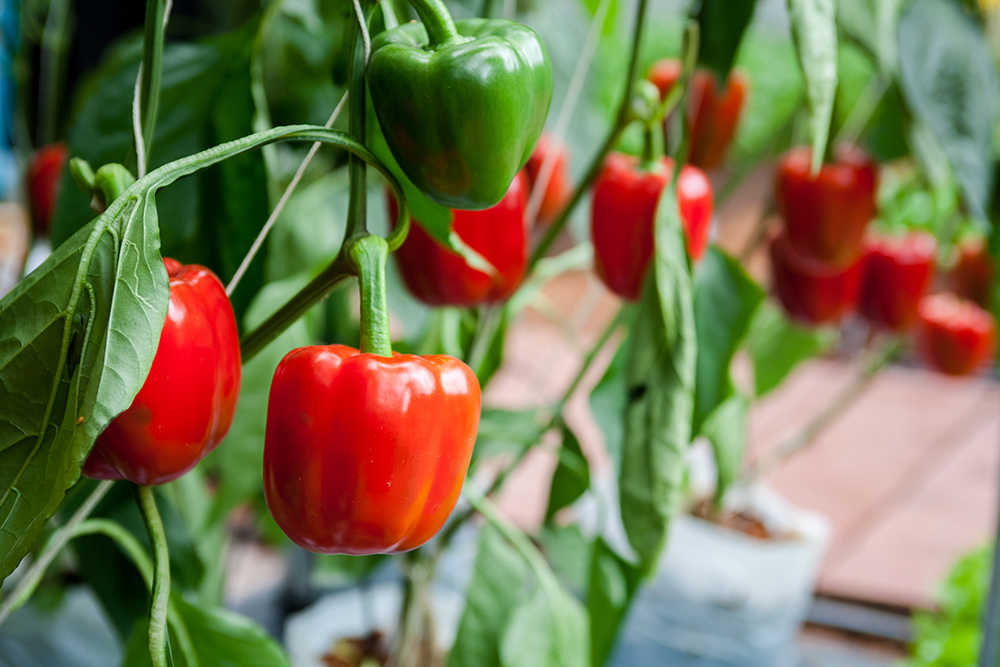How to Grow Bell Peppers in Your Summer Garden

Bell peppers are one of the most beloved and versatile veggies, and they’re also one of the most fun to grow in your own garden. They come in an assortment of shapes, sizes and colors and can make for a fun and delicious summer. If you want to try your hand at growing them for the first time, here’s what you need to know.
Choosing Your Peppers
Choosing which peppers to grow might be the hardest part. Make it easy on yourself by browsing local garden centers and nurseries and choosing among their offerings. You will likely find many tried-and-true options that are not only proven producers but also thrive in your local environment. You can also shop around at online seed suppliers and open your eyes to innumerable options.
See more: How to Grow and Harvest Summer Squash
How to Grow Bell Peppers From Seeds
If you decide to start your peppers from seed, you’ll need to start them indoors anywhere from 8 to 10 weeks before your final frost date. Not sure when that is? Run a quick online search with your zip code and the phrase “garden zone,” and you’ll find the important dates you need. Your next step is to gather seed-starting supplies from an online retailer or local garden center.

Planting Tips:
- Sow seeds according to packet instructions in trays or pots.
- To encourage faster germination, use a heating mat and grow lights.
- If you planted multiple seeds per cell or pot, thin them out as they grow
- Pot your seedlings when they have 5 to 8 leaves on their stems.
- Begin hardening off your seedlings 10 days before you plant them in the ground
Remember to keep your seedlings watered (preferably using the bottom watering method to avoid wetting the tender leaves and stems) and exposed to plenty of light as they grow.
How to Grow Bell Peppers From Seedlings
If you purchased seedlings around your final frost date, you may still need to harden them off. Set them outside on the days when the temperature is averaging 65 degrees to let them acclimate before putting them in the ground.
Before you put the plants in the ground, take some time to incorporate a high-quality, organic compost into the garden soil. Peppers, like tomatoes, are heavy feeders and will benefit from nutrient-rich soil.
Once you’ve enriched the soil with compost and the daily temperatures are averaging 65 degrees and above, tuck your plants into the ground, cover the roots with soil and tamp down around the base of each plant. Mulch around each plant (being careful not to overcrowd the stem) and give them a good watering.

Transplanting Tips:
- Transplant only after you are free from the danger of frost.
- Transplant on cloudy days or late in the evening to reduce the risk of transplant shock.
- Space your plants anywhere from 12 to 18 inches apart.
- Stake large varieties as soon as you plant to avoid harming their roots later.
Growing Guide
Peppers need regular watering and fertilizing to grow and produce fruit. If you live in a rainy climate, you may not need to water by hand. Otherwise, aim to provide the equivalent of 1 to 2 inches of water per week. Give long, deep drinks rather than small sips. Bell peppers will grow best if they are allowed to almost dry out between watering times.
While they grow best in warm temperatures, peppers can struggle in temperatures that regularly climb above 90 degrees. Try to give them afternoon shade in those heat peaks using row covers or shade cloth.
Some pepper growers suggest multiple fertilizers to support both the root systems and fruit production. But you could also go with a simple regimen and stick to a slow-release, all-purpose fertilizer. Make sure to follow the instructions on whatever fertilizer you choose to avoid burning your plants.

Harvesting Bell Peppers
Labeling your plants when they go in the ground is crucial if you want to grow a variety of colors. It will be especially important when the time comes to harvest. You want to pick peppers as soon as they reach maturity (in size and color). Use sharp, clean garden shears or scissors to make a clean cut from the plant.
See more: How to Grow and Care for Tomato Plants
Storing Bell Peppers
Peppers last a surprisingly long time in the fridge. Storing them in plastic bags can keep them good for up to 10 days. You can also core, slice and freeze them for future meals, such as chili or sheet pan fajitas. While not as common, you can even dehydrate peppers and grind them into powder to be sprinkled in soups and stews or on top of scrambled eggs.
One Comment
Join the discussion and tell us your opinion.




I’m trying to grow My first Pepper’s in a pot so fat so good